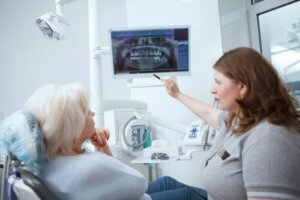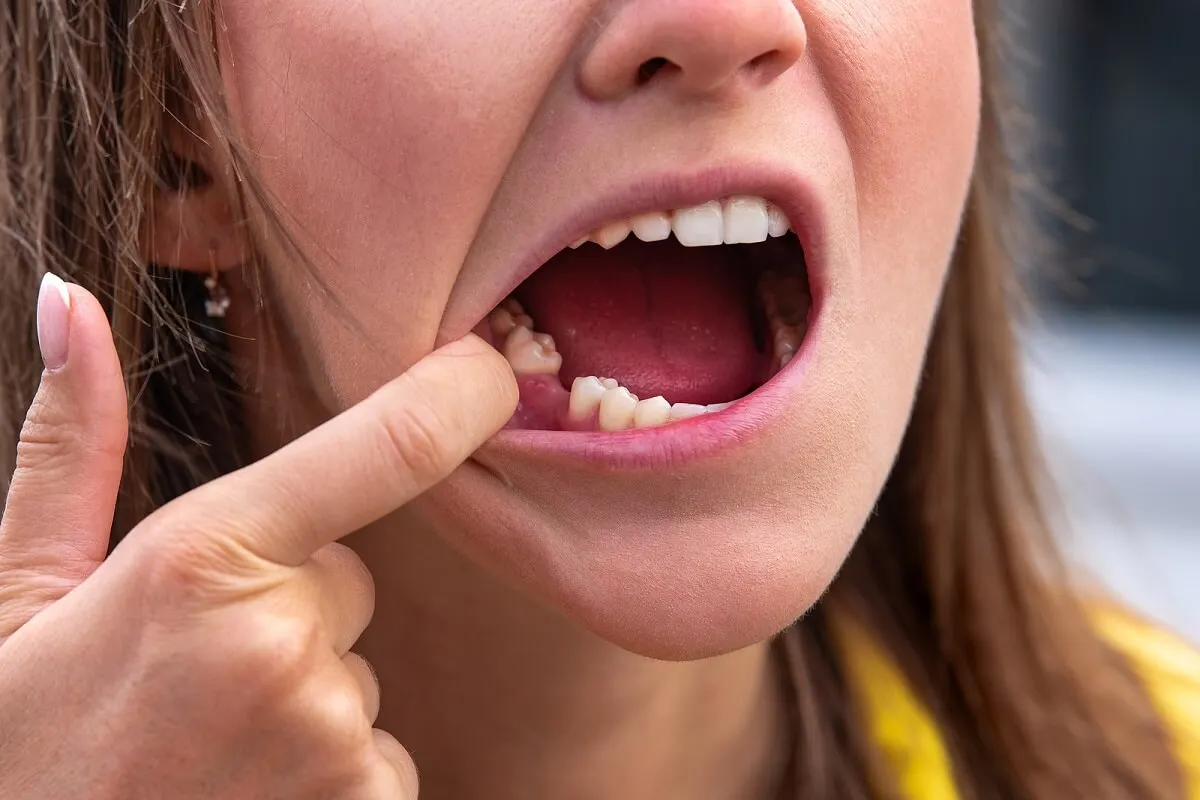The Link Between Osteoporosis and Dental Health


Written and verified by the dentist Vanesa Evangelina Buffa
When suffering from a systemic pathology, there are repercussions in several parts of the body. This is the case with osteoporosis, and we’ll be looking at the link between osteoporosis and dental health in this article.
This bone disease can have a negative influence on oral health. In fact, in some cases, it’s the oral symptoms that can help in its diagnosis. Like to know more about it? Keep reading!
What is osteoporosis?
Osteoporosis is a complex pathology that causes a decrease in bone density. It’s caused by a metabolic disorder that deteriorates the structure of the bones, which increases their fragility and the risk of suffering fractures. In general, its incidence increases with age, especially during the postmenopause.
Other risk factors include the following:
- Sex
- Age
- Genetics
- Ethnicity
- Lifestyle
- Nutrition
- Alcohol, smoking, or coffee habits
- A sedentary lifestyle
Fractures from minor trauma are the most recognized consequence of osteoporosis. The vertebrae and the head of the femur are the most common fracture areas.
You may be interested in: What Are the Risk Factors for Osteoporosis?
What’s the link between osteoporosis and dental health?
As we have mentioned, osteoporosis is a pathology that affects the different bones of the body, including the jaws. The jaw can suffer the same loss of bone substance as the rest of the bones.
The reduction in the density of the mandible and the upper jaw can lead to other alterations in the mouth. Periodontal disease, mobility and loss of teeth, and temporomandibular joint dysfunction are some of the associated problems.
The loss of height of the jaws and the decrease in the width of the alveolar ridges can cause deformities in the dental arches and face. This, in turn, leads to difficulties in dental treatment, such as placing implants or dentures.

Consequences of osteoporosis on dental health
The progression of osteoporosis in the jawbone causes various problems in dental health. The following are the most relevant.
A decrease in the alveolar ridge
Osteoporosis is one of the systemic factors that can cause loss of bone density in the alveolar ridge (the area of the jaw where the dental roots are located). Nutrition and hormonal imbalance are other determinants of this situation.
A deficient intake of calcium and phosphorus, as well as a low production of vitamin D, often cause bone resorption in the alveolar ridges. The hormonal imbalance of menopause is another situation that intensifies bone loss in women.
Reduced bone density in the jaw bone
Osteoporosis increases the porosity and trabecular spaces of the jaw bone. The cortical part of the jaw becomes thinner, especially in the area of the angle.
This loss of bone mass makes the jaws more fragile. For this reason, the placement of dental implants or prostheses becomes more difficult in these patients, which negatively affects their quality of life.
Loss of teeth
Patients with osteoporosis have a greater predisposition to lose their teeth or suffer edentulism. However, this association may also be due to other factors such as advanced age, smoking, poor dental hygiene or oral conditions typical of aging.
The decrease in jaw bone density and the loss of the alveolar bone where the teeth are inserted means that there’s a lack of support for the teeth. The teeth will start to move and may fall out.
Periodontal problems
Although osteoporosis isn’t the cause of periodontal disease, the consequences of this pathology are more serious in patients who suffer from it. In these cases, periodontal disease advances far more quickly.
The development of periodontal sacs, the loss of bone insertion and the consequent mobility or loss of teeth is greater in people with osteoporosis.
Read more: Dental Implant Prosthetics: What They Are and the Different Types Available
Complementary diagnostic methods for osteoporosis
As we have already mentioned, it’s often the dental symptoms that lead medical experts to suspect osteoporosis. Some complementary methods used in dental practices will help to guide the patient in seeking medical help.
In addition, identifying the disease helps the dentist to reconsider or replace certain therapy the patient may be receiving. Here are some dental studies that can show the presence of bone lesions caused by osteoporosis:
- Panoramic X-ray: Also called “orthopantomography”, it’s frequently performed in dental clinics to obtain a general image of the bone and dental structures. Altered appearance of the bone cortex, a decreased alveolar ridge height, and poor quality bone density may indicate the presence of osteoporosis.
- Computed Tomography (CT): Nowadays, this is performed digitally with a lower radiation dose than conventional methods. This test allows hundreds of images to be taken from different angles of the mouth for detailed study. The professional may detect changes that make them suspect an incipient osteoporosis.
If the symptomatology and complementary studies alert to the presence of osteoporosis, the dentist will make the corresponding referral to a specialist.
Doctors will perform specific studies, such as a densitometry. Blood and urine tests may also be performed to help confirm the diagnosis.
Depending on the results, the appropriate treatment for the case will be recommended. In general, several experts are qualified to deal with a patient with osteoporosis: general practitioners, clinicians, gynaecologists, endocrinologists, and rheumatologists.
Tips to reduce the effects of osteoporosis on dental health
Putting some of these recommendations into practice can help to reduce the consequences of osteoporosis on dental health.
- Proper nutrition: Having a varied, nutritious diet abundant in calcium can help reduce the effects of osteoporosis in the mouth. Almonds, dairy products and supplements help to incorporate these elements.
- Get frequent physical activity.
- Avoid harmful habits: Stop smoking and cut down on alcohol and caffeine.
- Expose yourself to the sun: This favors the synthesis of vitamin D which increases the absorption of calcium.
- Maintain proper oral hygiene: Brush your teeth three times a day with fluoride toothpaste. Complement with dental floss and mouthwashes.
- Keep dentures clean and check them every 6 months.
- Visit the dentist regularly. This helps detect any problems early and find an immediate solution. In addition, regular cleanings help keep your teeth and gums healthy.
- Inform the dentist if you have a diagnosis of osteoporosis and indicate the medications you’re taking to treat this condition.

Act in time to prevent progression
With the increase in life expectancy in the general population, osteoporosis is becoming an increasingly common health problem. Given the relationship of this condition with age, more and more people will be at risk of suffering from it.
This disease affects the quality of the bones and its appearance in the jaw has a negative impact on dental health. The decrease in bone mass and the loss of alveolar bone can lead to the loss of teeth and the impossibility of rehabilitative treatments.
For this reason, it’s essential to be aware of the importance of preventing the disease or reducing its effects through a healthy lifestyle. Regular medical and dental check-ups help to establish an early diagnosis in order to prevent the pathology from progressing.
All cited sources were thoroughly reviewed by our team to ensure their quality, reliability, currency, and validity. The bibliography of this article was considered reliable and of academic or scientific accuracy.
- Fernández-Ávila, D. G., Bernal-Macías, S., Parra, M. J., Rincón, D. N., Gutiérrez, J. M., & Rosselli, D. (2020). Prevalencia de osteoporosis en Colombia: datos del registro nacional de salud del 2012 al 2018. Reumatología Clínica.
- Barrios-Moyano, A., & De la Peña-García, C. (2018). Prevalencia de osteoporosis y osteopenia en pacientes laboralmente activos. Acta ortopédica mexicana, 32(3), 131-133.
- Espitia-De-La-Hoz, F. J. (2021). Osteoporosis en mujeres en climaterio, prevalencia y factores de riesgo asociados. Revista Colombiana de Ortopedia y Traumatología.
- Claros, J. J. R. (2021). Osteoporosis en los maxilares y sus métodos de diagnóstico: Revisión de literatura. Odovtos-International Journal of Dental Sciences, 23(1), 53-63.
- Farré Pagès, N. (2017). Estudio comparativo entre la densidad radiológica mediante tomografía computerizada de haz cónico y el metabolismo óseo de los maxilares en pacientes con y sin osteoporosis (Doctoral dissertation, Universitat Internacional de Catalunya).
- Garrido Martínez, M. (2021). Relación entre enfermedad periodontal y osteoporosis.
- Vizcaino Bautista, E. N. (2020). Enfermedad periodontal y osteoporosis (Bachelor’s thesis, Universidad de Guayaquil. Facultad Piloto de Odontología).
- Archila Acero, D. Y. (2019). Padecimiento de osteoporosis en pacientes adultos relacionado a la perdida de órganos dentarios.
- Gamboa Fernández, J. E., Otero Guaracao, M. A., Parada Ortega, G. P., & Parra Viviescas, M. M. Relación entre la periodontitis y la osteoporosis: un estudio bibliométrico.
This text is provided for informational purposes only and does not replace consultation with a professional. If in doubt, consult your specialist.








